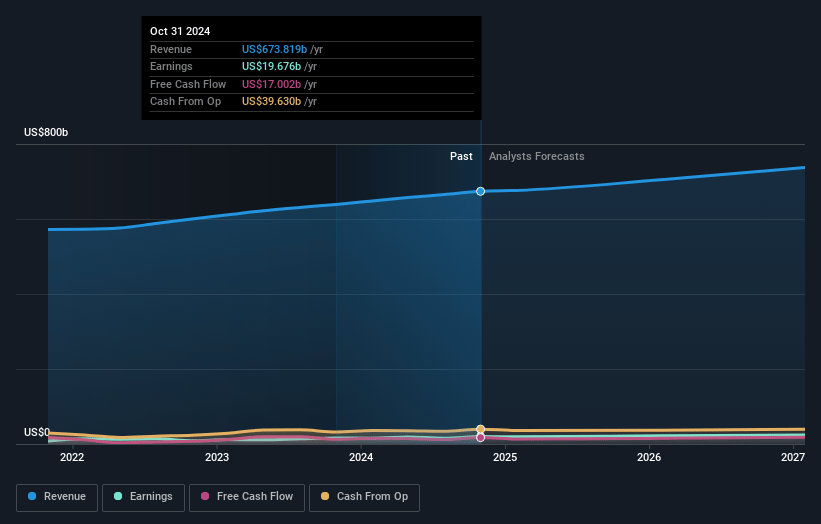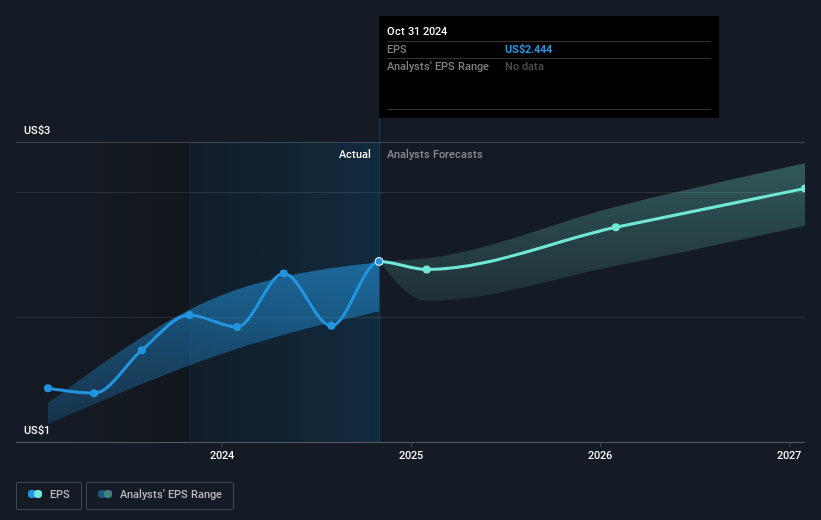Key Takeaways
- Expansion into higher-margin ventures like membership, marketplace, and advertising enhances profitability and net margins.
- Strategic supply chain investments and e-commerce enhancements are positioned to boost operational efficiency and drive top-line growth.
- Walmart faces risks from currency fluctuations, e-commerce transition costs, expansion execution, inflation pressures, and investment efficiency impacting revenue and profitability.
Catalysts
About Walmart- Engages in the operation of retail, wholesale, other units, and eCommerce worldwide.
- Walmart is focused on growing higher-margin businesses such as membership, marketplace, and advertising, which are expected to drive operating income growth faster than sales, thereby enhancing net margins and profitability.
- Significant investments in supply chain automation and technology are anticipated to lower costs and improve operational efficiency, contributing to improved net margins and higher return on investment (ROI).
- The anticipated IPO of Walmart’s fintech business, PhonePe, in India could introduce a substantial new revenue stream, enhancing overall earnings and providing liquidity for further investments.
- Walmart has expanded its e-commerce capabilities with rapid delivery options and streamlined operations that are expected to boost top-line growth and improve e-commerce profitability, positively affecting net margins.
- The company’s strategic focus on convenience and enhanced delivery options, like pharmacy integration and fast shipping, is expected to drive customer acquisition and retention, increasing revenue and positively impacting earnings.
Walmart Future Earnings and Revenue Growth
Assumptions
How have these above catalysts been quantified?- Analysts are assuming Walmart's revenue will grow by 4.1% annually over the next 3 years.
- Analysts assume that profit margins will increase from 2.9% today to 3.4% in 3 years time.
- Analysts expect earnings to reach $25.8 billion (and earnings per share of $3.27) by about April 2028, up from $19.4 billion today. However, there is some disagreement amongst the analysts with the more bullish ones expecting earnings as high as $28.7 billion.
- In order for the above numbers to justify the analysts price target, the company would need to trade at a PE ratio of 39.4x on those 2028 earnings, up from 39.1x today. This future PE is greater than the current PE for the US Consumer Retailing industry at 24.8x.
- Analysts expect the number of shares outstanding to decline by 0.33% per year for the next 3 years.
- To value all of this in today's terms, we will use a discount rate of 6.35%, as per the Simply Wall St company report.
Walmart Future Earnings Per Share Growth
Risks
What could happen that would invalidate this narrative?- Currency fluctuations remain a concern, as foreign exchange rates have already been a headwind to sales and operating income, potentially affecting overall reported revenue and profitability.
- The transition to more e-commerce and digital transactions implies a higher SG&A expense compared to traditional retail, which could pressure net margins if not offset by efficiency gains.
- Walmart's expansion plans, particularly in Canada and India via PhonePe, carry execution risks and could affect earnings if these investments don't deliver expected returns.
- Assumptions about low inflation, particularly in food and general merchandise, could be risky if actual inflation rises, resulting in unanticipated pricing pressure on Walmart's revenue.
- Increases in investment could impact cash flow and return on investment if anticipated efficiencies and revenue contributions from areas like tech and fulfillment centers do not materialize as expected.
Valuation
How have all the factors above been brought together to estimate a fair value?- The analysts have a consensus price target of $106.594 for Walmart based on their expectations of its future earnings growth, profit margins and other risk factors. However, there is a degree of disagreement amongst analysts, with the most bullish reporting a price target of $120.0, and the most bearish reporting a price target of just $63.0.
- In order for you to agree with the analyst's consensus, you'd need to believe that by 2028, revenues will be $768.1 billion, earnings will come to $25.8 billion, and it would be trading on a PE ratio of 39.4x, assuming you use a discount rate of 6.4%.
- Given the current share price of $94.85, the analyst price target of $106.59 is 11.0% higher.
- We always encourage you to reach your own conclusions though. So sense check these analyst numbers against your own assumptions and expectations based on your understanding of the business and what you believe is probable.
How well do narratives help inform your perspective?
Disclaimer
Warren A.I. is a tool utilizing a Large Language Model (LLM) that ingests data on consensus price targets, forecasted revenue and earnings figures, as well as the transcripts of earnings calls to produce qualitative analysis. The narratives produced by Warren A.I. are general in nature and are based solely on analyst data and publicly-available material published by the respective companies. These scenarios are not indicative of the company's future performance and are exploratory in nature. Simply Wall St has no position in the company(s) mentioned. Simply Wall St may provide the securities issuer or related entities with website advertising services for a fee, on an arm's length basis. These relationships have no impact on the way we conduct our business, the content we host, or how our content is served to users. The price targets and estimates used are consensus data, and do not constitute a recommendation to buy or sell any stock, and they do not take account of your objectives, or your financial situation. Note that Warren A.I.'s analysis may not factor in the latest price-sensitive company announcements or qualitative material.







